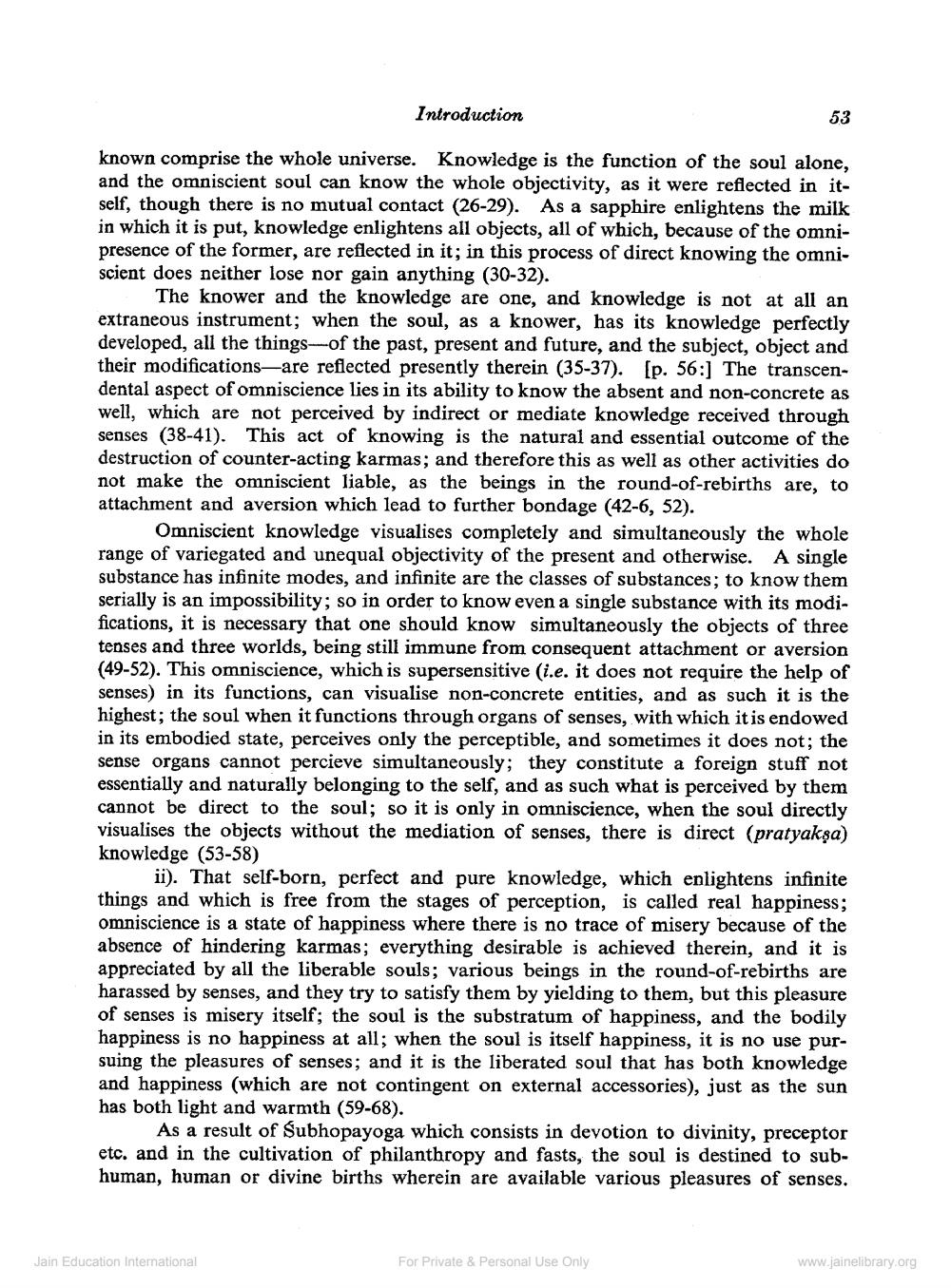________________
Introduction
53
known comprise the whole universe. Knowledge is the function of the soul alone, and the omniscient soul can know the whole objectivity, as it were reflected in itself, though there is no mutual contact (26-29). As a sapphire enlightens the milk in which it is put, knowledge enlightens all objects, all of which, because of the omnipresence of the former, are reflected in it; in this process of direct knowing the omniscient does neither lose nor gain anything (30-32).
The knower and the knowledge are one, and knowledge is not at all an extraneous instrument; when the soul, as a knower, has its knowledge perfectly developed, all the things-of the past, present and future, and the subject, object and their modifications are reflected presently therein (35-37). [p. 56:] The transcendental aspect of omniscience lies in its ability to know the absent and non-concrete as well, which are not perceived by indirect or mediate knowledge received through senses (38-41). This act of knowing is the natural and essential outcome of the destruction of counter-acting karmas; and therefore this as well as other activities do not make the omniscient liable, as the beings in the round-of-rebirths are, to attachment and aversion which lead to further bondage (42-6, 52).
Omniscient knowledge visualises completely and simultaneously the whole range of variegated and unequal objectivity of the present and otherwise. A single substance has infinite modes, and infinite are the classes of substances; to know them serially is an impossibility; so in order to know even a single substance with its modifications, it is necessary that one should know simultaneously the objects of three tenses and three worlds, being still immune from consequent attachment or aversion (49-52). This omniscience, which is supersensitive (i.e. it does not require the help of senses) in its functions, can visualise non-concrete entities, and as such it is the highest; the soul when it functions through organs of senses, with which it is endowed in its embodied state, perceives only the perceptible, and sometimes it does not; the sense organs cannot percieve simultaneously; they constitute a foreign stuff not essentially and naturally belonging to the self, and as such what is perceived by them cannot be direct to the soul; so it is only in omniscience, when the soul directly visualises the objects without the mediation of senses, there is direct (pratyakşa) knowledge (53-58)
ii). That self-born, perfect and pure knowledge, which enlightens infinite things and which is free from the stages of perception, is called real happiness; omniscience is a state of happiness where there is no trace of misery because of the absence of hindering karmas; everything desirable is achieved therein, and it is appreciated by all the liberable souls; various beings in the round-of-rebirths are harassed by senses, and they try to satisfy them by yielding to them, but this pleasure of senses is misery itself; the soul is the substratum of happiness, and the bodily happiness is no happiness at all; when the soul is itself happiness, it is no use pursuing the pleasures of senses; and it is the liberated soul that has both knowledge and happiness (which are not contingent on external accessories), just as the sun has both light and warmth (59-68).
As a result of Subhopayoga which consists in devotion to divinity, preceptor etc. and in the cultivation of philanthropy and fasts, the soul is destined to subhuman, human or divine births wherein are available various pleasures of senses.
Jain Education International
For Private & Personal Use Only
www.jainelibrary.org




